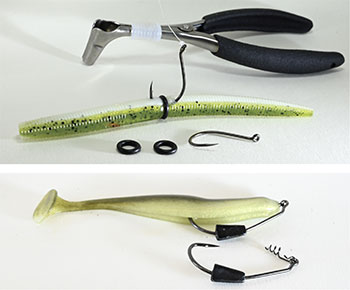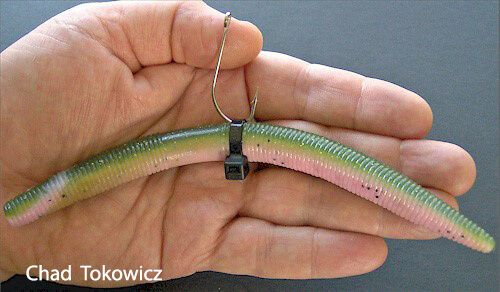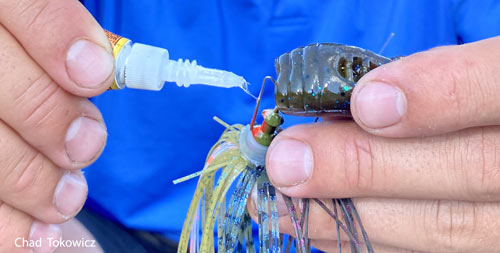Home → Fishing & Boating → Fishing → Fishing with Soft Plastic Lures
Fishing with Soft Plastic Lures

O-rings and hooks with built-in retention devices such as twist locks
and bait keepers help
keep lures where they belong.
Soft plastic lures are popular fishing tackle; and just like all other equipment, it’s your responsibility to properly maintain and dispose of them. Over the years, plastic lures have been improperly used and disposed of, consequently ending up on lake bottoms or in fish stomachs. Fish can ingest these lures off the bottom, and that can negatively impact their health. Soft plastic lures on the land or in the water also pose environmental concerns.
Some lures end up in the water intentionally, while others fall off hooks unintentionally. Do your part to help keep Maine’s waters clean and fisheries healthy:
1. Properly dispose of soft plastic lures
There is no doubt, discarding soft plastic lures on land or in the water is littering and poses environmental concerns. Instead, dispose of used lures in a trash can or recycling canister. Several Maine boat launches offer bait recycling canisters, and many local fishing clubs and retailers also offer bait recycling programs.
2. Secure your lure
Simply putting a soft plastic lure on a standard J-hook is not enough to help ensure your lure will stay on and not end up in the water or the stomach of a fish.
Secure your hook to help your lure stay where it belongs. Not only does this help preserve the quality of the fishery and water, but also saves you money from not losing lures and reduces time spent rebaiting.
There are several ways and products available to secure your lure, here are a few:
How to utilize O-rings
O-Ring: Much like Zip Ties O-rings can also be used as a means of securing wacky rigged soft plastic worm baits. Companies such as Fattube, Lethal Weapon, O-Wacky, Yum, and Wacky Tool all create tools specifically designed to help anglers use O-rings on soft plastic worm baits.
- Step 1: Choose soft plastic worm bait of your choice.
- Step 2: Insert bait into applicator tube.
- Step 3: Firmly holding bait in the applicator tube, slide the O-Ring down the tube and onto the bait. Slide the O-Ring to the middle of the bait.
- Step 4: Slide hook under the O-ring, wedging it in-between the O-Ring and the bait. The o-ring should be tight enough on the bait as to keep it firmly in place on the hook.
- Step 5: Cast and catch!
Tips: Do not reuse the O-Rings.
How to make a swimbait keeper
How to customize your jig and trailer retention for bass fishing
Other popular options:
- Zip Ties: Zip Ties can be used in the place of a rubber O-Ring to firmly secure a wacky rigged soft plastic worm. Although the traditional wacky rig requires the hook to be pierced through the middle the bait, the use of a zip tie will extend the useable life of the bait while minimizing loss as instead of hooking through the bait, the hook will be slid underneath the zip tie, sitting between the tie and the bait. After setting the hook on a fish the bait will slide up and away from the hook but staying on the line. This allows the angler to continue using the bait even after many catches.
- Step 1: Choose soft plastic worm bait of your choice.
- Step 2: Chose zip tie in color that complements or matches color of bait.
- Step 3: Firmly fasten zip tie to the center of the bait. Once tightened, cut off the excess so it is flush with the head.
- Step 4: Slide hook under the zip tie, wedging it in-between the zip tie and the bait. The Zip tie should be tight enough on the bait as to keep it firmly in place on the hook.
- Step 5: Cast and catch!

- A hook with a twist lock or built-in bait holding device: Examples are Mustad Ultra point Impact soft plastic hooks or Owner Twistlock hooks. These are a bit more expensive than traditional hooks, but in the long run helps keep the bait on the hook and extends the life of the soft plastic.
- Step 1: Screw the head of the plastic bait onto the device.
- Step 2: Secure the opposite end of the soft plastic to the hook so the lure extends from the “screw” piece straight down to the point of the hook (sometimes referred to as a ‘Texas rig’).
- Step 3: Cast and catch!
- Bait stop: These small, durable pieces of rubber keep the soft plastic in place and prevents them from sliding down.
- Step 1: Chose your soft plastic lure of choice and slide it onto the hook.
- Step 2: Slide the bait stop onto the hook against the soft plastic.
- Step 3: Cast and catch!
- Heavy monofilament fishing line: Another method you can use to help keep the bait from not sliding down the hook shank and eventually causing the bait to easily fall off the hook is using a piece of heavy monofilament fishing line.
- Step 1: Cut a piece of heavy line (40 pound test for example) about 3” or 4” long.
- Step 2: Thread the plastic bait onto the hook.
- Step 3: Impale the heavy fishing line through the plastic bait and into the eye of the hook and out the other side of the soft plastic lure.
- Step 4: Snip the ends flush with the bait.
- Step 5: Cast and catch!
 Super Glue for Jig Trailers: Although many jigs now come with metal keepers that are designed to secure your soft plastic lure trailers, one simple extra step can increase their effectiveness.
Super Glue for Jig Trailers: Although many jigs now come with metal keepers that are designed to secure your soft plastic lure trailers, one simple extra step can increase their effectiveness.
- Step 1: Choose your soft plastic lure to attach as a trailer.
- Step 2: Slide your trailer onto the hook and secure the SPL by gluing to hook shank at points of attachment by slightly pulling the lure back and applying glue to the hook shank and then pulling the lure over the glued area of the hook shank.
- Step 3: Cast and catch!
- Step 1: Choose your soft plastic lure to attach as a trailer.
3. Check your bait often
Don’t risk it – If you think you can “get a few more casts,” just replace it!
Soft plastic lures can wear out and get brittle, stretch, or rip, increasing the likelihood that they could fall off your hook. The best thing you can do to prevent that is inspect your soft plastic lure frequently. After catching a fish, make sure your lure is still intact. If it is worn or close to falling off, either replace it with a new bait, rehook it, or repair it. Technology has come a long way since plastic lures were first introduced, and many on the market today are made with more durable materials for a longer lifespan and have built-in lure retention devices.
Remember, it is time to replace or repair your lure if:
- The lure keeps sliding down the hook
- The lure has a minor cut
- The plastic is stretched or brittle
- You have caught several fish and worked the lure over abrasive cover
Frequently asked questions
What is a soft plastic lure?
Soft plastic lures have been growing in popularity over the last 20 years as manufactures have released a greater variety and selection. Soft plastic lures come in all different colors, shapes, and sizes, ranging from soft plastic worms and grubs to baitfish and frogs. The lures may come with hooks attached, or you may need to attach the hook yourself. Many anglers prefer soft plastic lures over hard-bodied lures due to their more natural feel.
Are biodegradable lures safer to use?
Not necessarily. Although some products are marketed as biodegradable, little compelling data supports these claims and they do not comply with existing national testing standards for testing biodegradability. In addition, the lure manufacturing industry has not developed their own standards for manufacturers promoting more environmentally friendly soft plastic lures.
How do soft plastic lures impact the health of a fish?
Fish readily feed on discarded or lost soft plastic lures found on the bottom of Maine’s waters. Limited research indicates some fish like bass can regurgitate plastic lures, but other fish like brook trout may not and since soft plastic lures do not readily decompose in fish or in the water, and they also tend to swell over time, their accumulation in fish stomachs may alter feeding behaviors and adversely impact fish health.
I have never found a lure in the stomach of a fish, is this really a problem?
Anglers commonly report catching fish that contain soft plastic lures. Soft plastic lures are most often found in lakes with bass, since they are a popular lure for bass fishing. Bass are found primarily in the southern and coastal portion of the state. An examination of 18,000 stomachs from fish by MDIFW revealed on average only 2% of the fish had soft plastic lures in their stomachs. However, some waters experience elevated rates of ingestion influenced by water clarity, bottom type, type of fish, and availability of other prey. Since soft plastic lures do not tend to decompose in water, they can accumulate.
What is the Maine Department of Inland Fisheries and Wildlife doing to protect the state’s fisheries from soft plastic lures?
The Department is committed to educating anglers on the environmental concerns related to soft plastic lures in the water and on the land, proper disposal of soft plastic lures, and steps to take to prevent unintentional loss while fishing. MDIFW’s goal is to significantly reduce the number of soft plastic lures ending up in Maine’s waters and land while keeping this popular fishing lure available to anglers.
Why would anyone dispose of a lure in the water?
Most anglers values Maine’s prized fisheries and would never intentionally litter in the waterways. However, some lures end up in the water due to unintentional loss while fishing. That’s why securing your lure and checking your lure frequently is so important.
Where can I find devices to secure soft plastic lures?
Most fishing supply stores that sell soft plastic lures also sell retention devices.
Why am I still seeing soft plastics in fish?
Even if all anglers begin to follow best practices on maintaining and disposing of soft plastic lures it will take a while before the lures that are already in the waterways are gone.